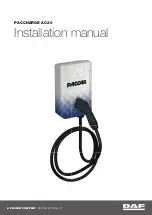
User’s Guide
ACC-7025
M7100 Terminal Charger
© 2005 American Microsystems Ltd.
Last Revision: February 2, 2005
Website: www.amltd.com
Regulatory Information
All American Microsystems, Ltd. devices are designed to be compliant with rules and
regulations in locations they are sold and will be labeled as required. Any changes or
modifications to American Microsystems, Ltd. equipment, not expressly approved by
American Microsystems, Ltd., could void the user's authority to operate the
equipment.
Power Supply
Use only an American Microsystems, Ltd. approved Power Supply, output rated 5
VDC and minimum 2A. The Power Supply is certified to EN60950.
Disclaimer
American Microsystems, Ltd. reserves the right to make changes in specifications and
other information contained in this document without prior notice, and the reader
should in all cases consult American Microsystems, Ltd. to determine whether any
such changes have been made. The information in this publication does not
represent a commitment on the part of American Microsystems, Ltd.
American Microsystems, Ltd. shall not be liable for technical or editorial errors or
omissions contained herein; nor for incidental or consequential damages resulting
from the furnishing, performance, or use of this material.
This document contains proprietary information that is protected by copyright.
All rights are reserved. No part of this document may be photocopied, reproduced, or
translated into another language without the prior written consent of American
Microsystems, Ltd.
FCC Declaration of Conformity
Product Name: M7100 Terminal Charger
Model Number: ACC-7025
Radio Frequency Interference Requirements
This equipment complies with Part 15 of the FCC rules. Operation is subject to the
following two conditions: (1) This equipment may not cause harmful interference,
and (2) this equipment must accept any interference received, including interference
that may cause undesired operation.
This equipment has been tested and found to comply with the limits for a Class B
digital device, pursuant to Part 15 of the FCC Rules. These limits are designed to
provide reasonable protection against harmful interference when the equipment is
operated in a residential environment. This equipment generates uses and can
radiate radio frequency energy, and if not installed and used in accordance with the
instructions, may cause harmful interference to radio communications. However,
there is no guarantee that interference will not occur in a particular installation. If you
determine the equipment does cause harmful interference to radio or television
reception (this may be determined by monitoring the interference while turning the
equipment off and on), you are encouraged to try to correct the interference by one
of the following measures:
·
Reorient or relocate the receiving antenna.
·
Increase the separation between the equipment and receiver.
·
Connect the equipment into an outlet on a circuit different from that to
which the receiver is connected.
·
Consult the dealer or an experienced radio or TV technician for help.
Radio Frequency Interference Requirements - Canada
This Class B digital apparatus complies with Canadian ICES-003.
Cet appareil numérique de la classe B est conforme à la norme NMB-003 du Canada.
Marking and European Economic Area (EEA)
Products intended for sale within the European Union are marked with
the CE mark which indicates compliance to applicable Directives and
European Normes (EN), as follows. Amendments to these Directives or
EN’s are included.
·
Electromagnetic Compatibility Directive 89/336/EEC
· Low
Voltage
Directive
73/23/EEC
©
American Microsystems, Ltd.
2190 Regal Parkway • Euless, TX 76040
Phone 817.571.9015 • Fax 817.571.6176
Communication Ports
The M7100 handheld terminal has 2 different styles of commu-
nications ports, RS-232 (RJ-45) and USB (Type II). The M7100
Cradle also has 2 communications ports, RS-232 (DB-9) and USB
(Type II). The M7100 Communications Cradle uses a standard
RS-232 (DB-9 Male – DB-9 Female) cable with a length of 3
Meters or less.
Both communication connectors on the back of the M7100
cradle are wired “straight through”. This means that the commu-
nications settings on the M7100 handheld terminal will deter-
mine the settings on the communication cradle. The M7100
Cradle has no internal or external settings that can be changed.
The slower RS-232 communication port is primarily used for
uploading and downloading of data files to the M7100 Batch
handheld terminal. File transfers for the M7100 RF handheld
terminal can be done using FTP. For more information on FTP
see the “FTP” section of this manual.
The full speed USB data port is used to load a new or updated
operating system into the M7100 handheld terminal only. Use
the AML USB Flash utility software to load the operating system.
DB-9 Pin out (RS-232)
1 – DCD
(Data Carrier Detect)
6
–
DSR
(Data Set Ready)
2 – RXD
(Receive Data)
7 – RTS
(Request To Send)
3 – TXD
(Transmit Data)
8 –CTS
(Clear To Send)
4 – DTR
(Data Terminal Ready)
9 – NC
(No Connection)
5 - GND
(Signal Ground)
©
American Microsystems, Ltd.
2190 Regal Parkway • Euless, TX 76040
Phone 817.571.9015 • Fax 817.571.6176
Normalización y Certificación Electronica (NYCE)
Safety NOM
/
NYCE-NOM-019-SCFI-1998
Safety of data processing equipment.




















